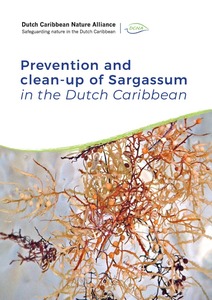| dc.coverage.spatial | Caribbean Sea | en_US |
| dc.coverage.spatial | Dutch Caribbean | en_US |
| dc.date.accessioned | 2020-04-21T21:06:01Z | |
| dc.date.available | 2020-04-21T21:06:01Z | |
| dc.date.issued | 2019 | |
| dc.identifier.citation | Dutch Caribbean Nature Alliance (2019) Prevention and clean-up of Sargassum in the Dutch Caribbean. Bonaire, Dutch Caribbean, Dutch Caribbean Nature Alliance, 30pp. DOI: http://dx.doi.org/10.25607/OBP-796 | en_US |
| dc.identifier.uri | http://hdl.handle.net/11329/1286 | |
| dc.identifier.uri | http://dx.doi.org/10.25607/OBP-796 | |
| dc.description.abstract | In 2011, the shores of several Caribbean islands and West African countries were inundated by unprecedented
quantities of pelagic sargassum. Since then, influxes of this golden-brown seaweed have become
a recurrent event in both the Caribbean Sea and West Africa, with observers in these regions reporting
levels reaching a critical high in 2018” (Hinds et al., 2016). Some piles of stranded sargassum towered
several meters high on beaches, and affected bays were covered with dense floating clusters of
the seaweed. Finding ways to clean-up sargassum from coastal ecosystems has become a priority
for the region. The recent and likely recurring seaweed influxes have given rise to a number of
socio-ecological and economic concerns, particularly in the hospitality and fisheries sectors, as
well as threatening already fragile and often endangered coastal ecosystems such as mangroves
and seagrass beds. The good news is that these negative effects do not seem to persist when the
sargassum is removed, with the physicochemical quality of the water returning to its prior state
(Anses, 2017). Cleaning-up large quantities of sargassum is however no easy or cheap feat. Strandings
have so far proven to be highly variable in terms of quantity and sites affected, making these
irregular events hard to predict and therefore mitigate. A recent estimate suggests that it will take
at least $120 million to clean up the sargassum inundations across the Caribbean (Milledge and
Harvey, 2016). “The sustainable management of sargassum influxes will require both local action
and regional co-ordination and collaboration, beyond areas under national jurisdiction. A better
understanding of the geographic origin, causes, spatial and temporal patterns, management
options, as well as the economic potential of sargassum is necessary if adaptive strategies are to
be implemented” (Hinds et al., 2016). This management brief, adapted from Hinds et al. (CERMES/
GCFI/SPAW Management Brief, 2016), focuses on the immediate problem of clean-up after mass
strandings of the weed, helping coastal communities find effective solutions for the collection and
use of sargassum. | en_US |
| dc.language.iso | en | en_US |
| dc.publisher | Dutch Caribbean Nature Alliance | en_US |
| dc.subject.other | Sargassum | en_US |
| dc.subject.other | Seaweed | en_US |
| dc.subject.other | Beach cleanup | en_US |
| dc.subject.other | Disposal | en_US |
| dc.subject.other | Containment booms | en_US |
| dc.subject.other | Management brief | en_US |
| dc.subject.other | Transport | en_US |
| dc.subject.other | Mitigation | |
| dc.title | Prevention and clean-up of Sargassum in the Dutch Caribbean. | en_US |
| dc.type | Report | en_US |
| dc.description.status | Published | en_US |
| dc.format.pages | 30pp. | en_US |
| dc.contributor.corpauthor | Dutch Caribbean Nature Alliance | en_US |
| dc.description.refereed | Refereed | en_US |
| dc.publisher.place | Bonaire, Dutch Caribbean | en_US |
| dc.subject.parameterDiscipline | Parameter Discipline::Biological oceanography::Macroalgae and seagrass | en_US |
| dc.description.currentstatus | Current | en_US |
| dc.description.sdg | 14.2 | en_US |
| dc.description.eov | Macroalgal canopy cover and composition | en_US |
| dc.description.bptype | Best Practice | en_US |
| dc.description.bptype | Manual (incl. handbook, guide, cookbook etc) | en_US |
| obps.resourceurl.publisher | https://www.dcnanature.org/ | en_US |
 Repository of community practices in Ocean Research, Applications and Data/Information Management
Repository of community practices in Ocean Research, Applications and Data/Information Management
